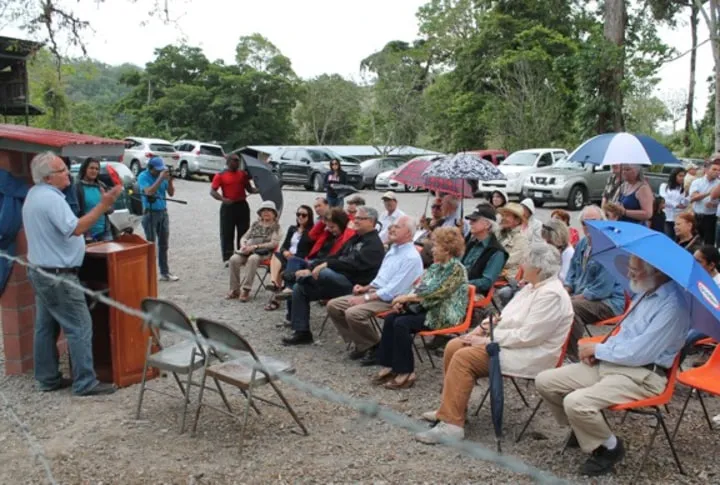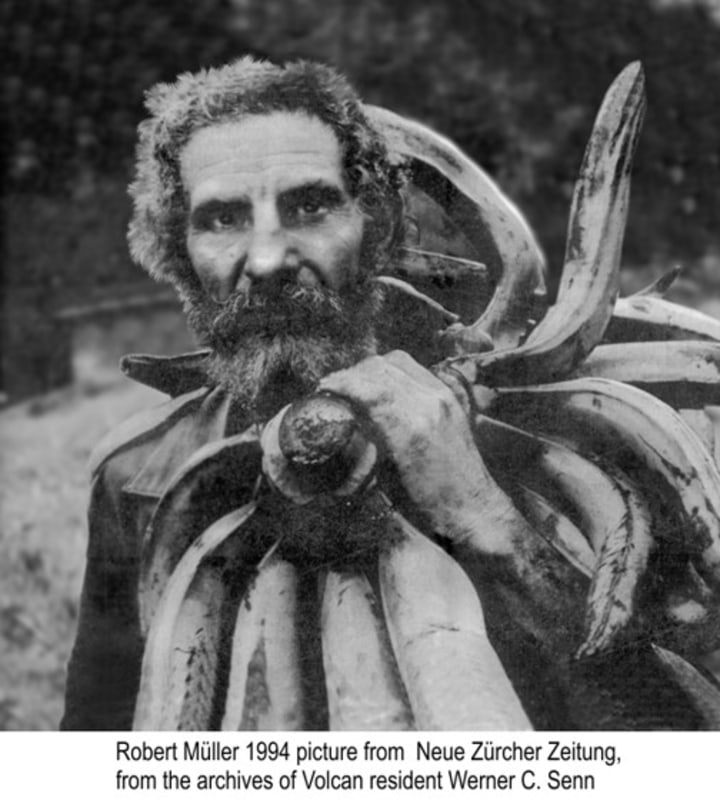Cotito massacre remembered.

March 1st. 2015. A small crowd gathers in the tiny hamlet of Cotito, Chiriquí, to unveil a memorial plaque and to remember a dark moment in Panama’s history.

The Plaque, written in German, Spanish and English tells of the massacre on July 7th , 1941 of 12 Swiss - German settlers and the wounding of 8 others by a reportedly drunken group of Panama’s national police. The plaque was unveiled by Albert Schmieder the last remaining survivor. This atrocity may have disappeared into the depths of History apart from two individuals- first the prosecutor who tried in vain to bring the perpetrators to justice and secondly his son who gathered the facts and put them in a book.

To put the events into an historical context, in 1941 Germany had invaded half of Europe. Although neither the U.S. or Panama were officially involved in the war - it was just a matter of time. Anti- German sentiment was wide spread and the United States asked Panama to identify or round up possible enemy aliens. The settlers were half Swiss -that was no problem, but their other half - was German.
The settlers were ordered to come down to the city of David (a three day horseback ride) and register. Their leader, Karl Lehner refused. On July 6th, some thirty police officers, under the command of Captain Antonio Huff, some armed with machine guns, surrounded the recently built stockade at Cotito. Some reports said the settlers were: Nazi fifth columnists, that they had secret radios, they had built an airfield, they were heavily armed. Most of these reports however, seemed to have surfaced after the massacre.

Cotito pictured in 2007.
The colonists , by all accounts were unarmed. This is borne out by the fact that their lifestyle decried the killing of chickens, frogs or even snakes. So why would they have weapons if hunting was absolutely no part of their culture?
They were followers of a rather bizarre U.S. cult figure called Father Divine. This charismatic black man believed he was God. The Cotito cult leader; Karl Lehner, a tall, authoritarian looking man, would have been classified in today’s society as an anti-government , anti-authoritarian survivalist. His arrogance and refusal to fully cooperate with the Panamanian authorities, was a major contributing factor to the massacre.

Charismatic cult leader Father Divine - he told his followers he was God.
According to a close neighbour, Ziska Hartmann, the shooting started around 6:30 on the morning of July 7th. The firing was sporadic and lasted about 15 minutes. The first person to be shot was Lucas Garcés - a probationary police officer, he sustained a non-life-threatening wound to the face. There is speculation that Garcés could have been shot accidentally by another policeman or was in fact the victim of his own ineptitude and his own firearm. Nevertheless, that first shot started the police gunfire which rained down on the colony from all sides.
Within minutes 10 people were dead, 2 died later and 8 were seriously injured. Apart from Garcés not one single policeman sustained an injury.
Alois Hartmann, a neighbour, arrived soon after the shooting stopped and complained bitterly about the massacre-the result was the police tied him to a tree for several days. This left him with a disabled hand that plagued him until his death. I heard from Hartmann’s family that the police also forced Alois to clean up the blood and the brains that were splattered over the walls and floors of the huts.
Some of the original black painted houses still survive to this day.
The police action on that fateful July morning did not go unnoticed and a very brave prosecutor, Abel Gómez Araúz, did try in vain to bring justice to the victims. For 12 long years the cover-up went on. To this day, not one of the police officers involved in the massacre has ever been prosecuted. See our story on police in central america here.
Chiriqui Libre editor, Iván Flores and myself started to assemble the facts about this case in 2008 in an effort to see that this shameful act would not be lost to future historians. Ivan Flores had an old worn copy of the Carlos Cuestas Gómez book, “Chronicle of a Forgotten Crime.” This was our starting point.
Later I found a rare copy of a similar book, called “Holocaust In Panama.” This was an English translation of a book by Aristides Hassan. This gave a similar account of the massacre at Cotito but surprisingly it stated that there was yet another massacre some days earlier in the town of Boquete. Suspicions arose when reading this other account as author Hassan’s style seemed to change from a matter of fact rendering of historical events at Cotito to a “pulp -fiction” style when relating the events at Boquete.
The English translator of the Carlos Cuestas book; David Fishlow, put both Ivan and myself straight about the Hassan book. “It’s a work of pure fiction” he told us.
Hassan had been paid to write a book that blackened the name of presidential candidate Arnulfo Arias ahead of national elections. Hassan had tried, unsucessfully, to play the Jewish card, saying that Arnulfo ordered a massacre of Jewish settlers in Boquete- fortunately there was no massacre of Jews in Boquete. The Hassan book even fooled CNN in the U.S.
In Volcan today there is one living witness of the after effects of the massacre, that is Swiss born Werner Senn. Werner, even as a young lad recalls the body of a woman with long flowing, blood drenched hair being carried on horseback through the town. The female body that Werner saw was most probably that of Mrs. Klara Werren. She was buried along with Karl Schmieder Jr. in the old Volcán cemetery - now the site of an agricultural store and bakery.
In Volcan today there is one living witness of the after effects of the massacre, that is Swiss born Werner Senn. Werner, even as a young lad recalls the body of a woman with long flowing, blood drenched hair being carried on horseback through the town. The female body that Werner saw was most probably that of Mrs. Klara Werren. She was buried along with Karl Schmieder Jr. in the old Volcán cemetery - now the site of an agricultural store and bakery.

The burial of Robert Muller in 2008 in the Volcan cemetary.

Robert was buried next to his mother who was also wounded in the massacre.

David Fishlow has translated the original Carlos Cuestas book about Cotito and has done a masterful job of unearthing even more details about this tragic event. The plaque he was instrumental in having erected stands on the edge of the Volcan- Rio Sereno road about a half hours drive west of Volcan. 200 hundred meters away down a rough gravel road is the unmarked mass grave of the settlers. The plaque and the book are testimony that even though this horrendous crime went unpunished - the perpetrators and more importantly, the innocent victims, will never be forgotten
This book is available both in paperback and e-format at Amazon.com

This is the final resting place of the victims in this unmarked grave, 200 meters from the present day plaque.

Albert Schmieder, the last remaining survivor of the massacre, stands beside the unveiled plaque with his grandson.
